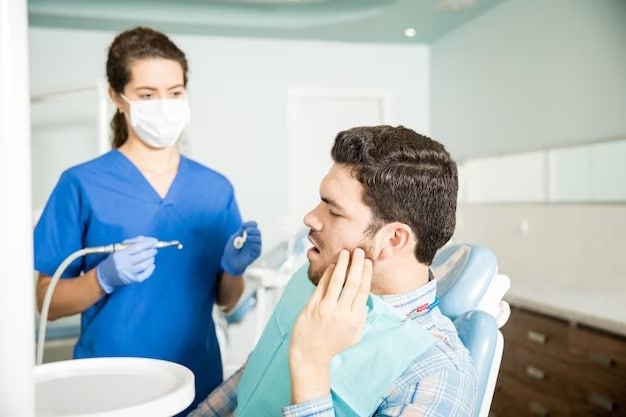Knowing how to handle a broken or chipped tooth cannot be overstated. Accidents can happen at any time; when they do, it’s crucial to be prepared. This comprehensive guide will walk you through the immediate steps for pain relief and preventing further damage to your teeth. By following these steps, you can ensure your dental health is not compromised in the face of unexpected mishaps.
Assessing the damage:
The first step in dealing with a broken or chipped tooth is to assess the extent of the damage. Not all cases are the same, and the severity of the injury can vary significantly. Here’s how you can identify if it’s a broken or chipped tooth and examine the damage:
Identifying if it is a broken or chipped tooth:
A chipped tooth typically involves a small piece of the tooth breaking off, leaving a rough, uneven surface. On the other hand, a broken tooth may entail more extensive damage, possibly exposing the inner layers of the tooth. Run your tongue over the affected area; if it feels sharp or jagged, it’s likely a chipped tooth.
Examining the severity of the damage:
Check for bleeding or swelling in the gum or lip area near the damaged tooth. Gently wiggle the tooth; if it moves, it may be more than a simple chip, and the damage may extend deeper into the tooth structure.
Managing pain:
Dealing with the pain caused by a broken or chipped tooth is a crucial step in this process. Here are some immediate measures you can take to alleviate discomfort:
Rinsing the mouth with warm salt water:
Mix half a teaspoon of salt in eight ounces of warm water. Gently swish the solution in your mouth for 30 seconds, then spit it out. This can help clean the area and reduce the risk of infection, providing relief from discomfort.
Applying a cold compress to reduce swelling:
Place an ice pack or a cold compress on the outside of your cheek near the injured tooth. Apply it for 15-20 minutes, with breaks in between. This will help reduce pain and swelling, making you more comfortable.
Over-the-counter pain relievers for temporary relief:
Non-prescription pain relievers like ibuprofen or acetaminophen can temporarily relieve pain and inflammation. Follow the recommended dosage on the packaging, and do not exceed the recommended dose.
Protecting the tooth:
While waiting for professional dental care, protecting the damaged tooth from further harm is essential. These steps can help prevent additional damage:
Covering the sharp or jagged edges with dental wax:
Dental wax can be found at most drugstores or pharmacies. Apply a small amount of wax to the jagged edges of the broken tooth to prevent it from cutting your tongue or cheek. This will make eating and speaking more comfortable.
Avoiding hard or sticky foods that can worsen the damage:
Avoid foods that require extensive chewing or are likely to get stuck in the broken tooth. Opt for soft, easy-to-eat options to prevent further damage or irritation while you wait for professional dental care.
Using a temporary dental filling kit to protect the tooth:
These kits are available over the counter at most drugstores. Follow the instructions carefully to create a protective layer over the damaged tooth. This can help preserve the tooth’s structure until you see a dentist.
Seeking professional help:
While the above steps can provide immediate relief and protection, contacting a dentist for a more permanent solution is essential. Here’s what you should do when seeking professional help:
Contacting a dentist for an emergency appointment:
Reach out to your dentist as soon as the injury occurs. Explain the situation and request an emergency appointment, emphasizing the issue’s urgency. Many dental offices have provisions for emergency cases, so don’t hesitate to reach out for immediate care.
Providing clear and detailed information about the injury:
Be ready to describe the damage’s extent, the injury’s location, and any pain or discomfort you are experiencing. This information will help your dentist prepare for the treatment, ensuring they can provide the best care possible.
Following the dentist’s advice and instructions:
Your dentist will assess the situation and recommend the appropriate treatment, which may involve bonding, dental crowns, or other procedures. Follow their advice and instructions closely to ensure a full recovery and maintain your oral health.
The Bottom Line
Handling a broken or chipped tooth is vital to maintaining dental health, especially in unexpected accidents. While providing immediate relief can bring comfort and protection, seeking professional assistance without delay is imperative. Taking these proactive steps is essential to ensure that your smile remains intact and your dental health is preserved in the long run.
When faced with a dental emergency, time is of the essence. The rapid response is key to minimizing potential long-term damage. Even small fractures or chips can escalate into more significant issues if left untreated. Thus, promptly consulting a dentist is crucial.
By acting swiftly and responsibly, you can make all the difference in preserving your beautiful smile and preventing further complications. Remember, your quick response and proper care are fundamental to your oral well-being.




